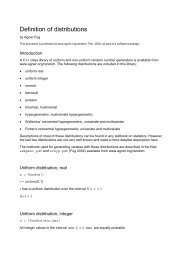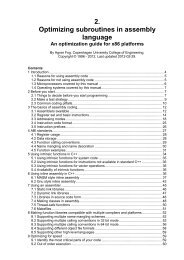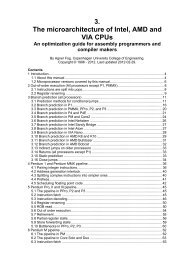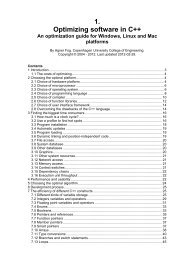4 Instruction tables - Agner Fog
4 Instruction tables - Agner Fog
4 Instruction tables - Agner Fog
You also want an ePaper? Increase the reach of your titles
YUMPU automatically turns print PDFs into web optimized ePapers that Google loves.
Merom<br />
Intel Core 2 (Merom, 65nm)<br />
List of instruction timings and μop breakdown<br />
Explanation of column headings:<br />
Operands:<br />
i = immediate data, r = register, mm = 64 bit mmx register, xmm = 128 bit xmm<br />
register, (x)mm = mmx or xmm register, sr = segment register, m = memory,<br />
m32 = 32-bit memory operand, etc.<br />
μops fused domain:<br />
μops unfused domain:<br />
p015: The total number of μops going to port 0, 1 and 5.<br />
p0: The number of μops going to port 0 (execution units).<br />
p1: The number of μops going to port 1 (execution units).<br />
p5: The number of μops going to port 5 (execution units).<br />
p2: The number of μops going to port 2 (memory read).<br />
p3: The number of μops going to port 3 (memory write address).<br />
p4: The number of μops going to port 4 (memory write data).<br />
Unit:<br />
Tells which execution unit cluster is used. An additional delay of 1 clock cycle<br />
is generated if a register written by a μop in the integer unit (int) is read by a<br />
μop in the floating point unit (float) or vice versa. flt→int means that an instruction<br />
with multiple μops receive the input in the float unit and delivers the output<br />
in the int unit. Delays for moving data between different units are included under<br />
latency when they are unavoidable. For example, movd eax,xmm0 has an<br />
extra 1 clock delay for moving from the XMM-integer unit to the general purpose<br />
integer unit. This is included under latency because it occurs regardless<br />
of which instruction comes next. Nothing listed under unit means that additional<br />
delays are either unlikely to occur or unavoidable and therefore included in the<br />
latency figure.<br />
Latency:<br />
Reciprocal throughput:<br />
The number of μops at the decode, rename, allocate and retirement stages in<br />
the pipeline. Fused μops count as one.<br />
The number of μops for each execution port. Fused μops count as two. Fused<br />
macro-ops count as one. The instruction has μop fusion if the sum of the numbers<br />
listed under p015 + p2 + p3 + p4 exceeds the number listed under μops<br />
fused domain. An x under p0, p1 or p5 means that at least one of the μops listed<br />
under p015 can optionally go to this port. For example, a 1 under p015 and<br />
an x under p0 and p5 means one μop which can go to either port 0 or port 5,<br />
whichever is vacant first. A value listed under p015 but nothing under p0, p1<br />
and p5 means that it is not known which of the three ports these μops go to.<br />
This is the delay that the instruction generates in a dependency chain. The<br />
numbers are minimum values. Cache misses, misalignment, and exceptions<br />
may increase the clock counts considerably. Floating point operands are presumed<br />
to be normal numbers. Denormal numbers, NAN's and infinity increase<br />
the delays very much, except in XMM move, shuffle and Boolean instructions.<br />
Floating point overflow, underflow, denormal or NAN results give a similar<br />
delay. The time unit used is core clock cycles, not the reference clock cycles<br />
given by the time stamp counter.<br />
The average number of core clock cycles per instruction for a series of independent<br />
instructions of the same kind in the same thread.<br />
Integer instructions<br />
<strong>Instruction</strong> Operands μops<br />
fused<br />
μops unfused domain Unit<br />
domain<br />
p015 p0 p1 p5 p2 p3 p4<br />
Page 82<br />
Latency<br />
Reciprocalthroughput






